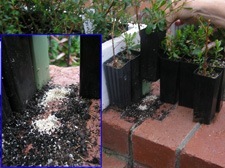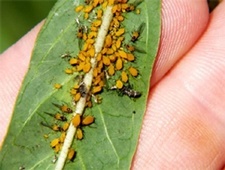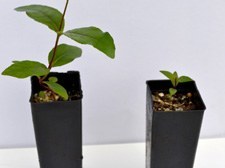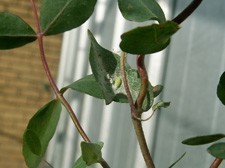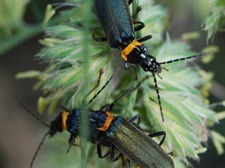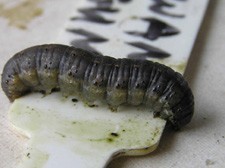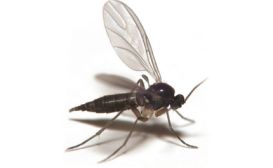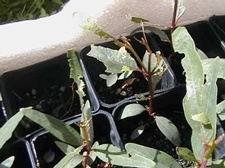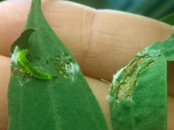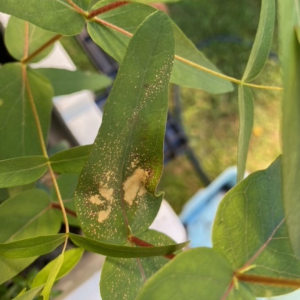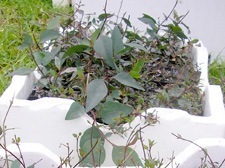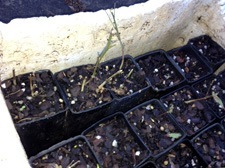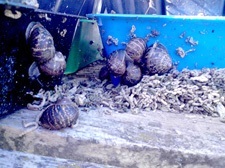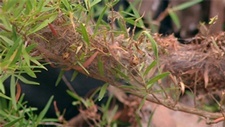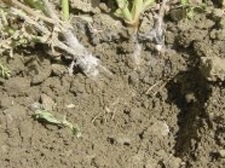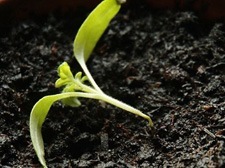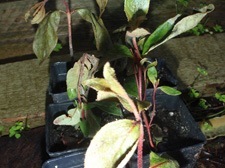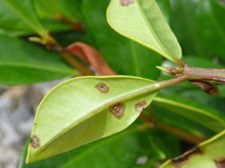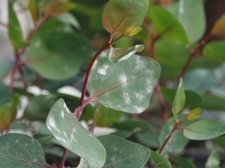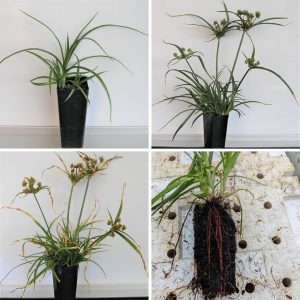Pests and disease
Identify and control pests and diseases on your seedlings.
Controlling pests and diseases
Use a garlic spray on the leaves to discourage munching. Dispose of them as your conscience permits.
Garlic is effective against a wide range of diseases and insects at different stages in their life cycle (egg, larvae, adult). This includes ants, aphids, army worms, caterpillars, mice, mites, as well as fungi and bacteria.
Spray Option 1: Blend 100 grams of grated and crushed garlic cloves, 0.5 litres of water and 10 grams of soap (Use potash based soft soap that is used for washing dishes and not the modern washing powders that contain caustic soda which will harm plants). Mix well. Strain the mixture through a fine cloth. Dilute the solution in 5 litres of water. Mix the solution well before applying to the affected plants. Use as a spray or sprinkle using twigs or grass tied together to form a whisk. For best effect, use the mixture immediately.
Spray Option 2: One whole garlic bulb, Two cups water, Four litres water. Combine in blender the entire garlic bulb and two cups water, and blend on high speed until garlic is finely pureed. Put in storage container and set aside for a day. Strain out pulp, and then mix liquid with one gallon water in sprayer. Spray tops and bottoms of leaves thoroughly. Apply about once a week, and after a rain.
Can’t find the pest that is damaging your seedlings? Roll up some corrugated cardboard amongst the tubes and leave overnight. You may find illusive bugs have taken refuge in the corrugation of the cardboard.
Pests
A pest is a plant or animal whose behaviour interferes with the success of other species.
This includes slugs, snails, caterpillars, cutworms, grasshoppers, birds, aphids. All require immediate treatment. Basically, whatever pests you have in your garden are likely to turn up on your seedlings.
Watch your seedlings for signs as well as the insects themselves. Signs include holes in leaves, and top leaves rolled up or joined together. Bare stems and skeletonised leaves are extreme symptoms.
However, not all insects will cause damage to your seedlings; some are beneficial as they prey on others. Good insects include ladybirds, wasps, bees, praying mantis and some other bugs.
Ants
Ants can often co-exist without too much effect on the grower. Ants are considerable scavengers who prey on things for the liquid food which they feed to those in the nest.
They often form a symbiotic relationship with aphids, and generally represent a threat to other insects rather than plant-life. They may affect plants by disturbing the soil around the roots during the process of building their nests, but this is rarely cause for concern.
Cause
Their presence is usually a sign that seedlings are too dry and warm.
Prevention
Where food or moisture is scarce they may enter houses or buildings looking for it. Their presence is usually a sign that seedlings are too dry and warm. They are particularly attracted to dry, easily excavated sites so will settle in rotting wood, sand between bricks or paving as well as the base of pots and tubes.
Keep seedling tubes in the polystyrene boxes or trays to keep moist. Make sure the whole tube is kept moist. Dry tubes will form air pockets or a crust on the surface and the ants will consider this a perfect location to create a colony. Avoid having the seedlings sitting directly on the bench surface.
Cure
Ants can generally be dealt with by pouring boiling water down the main nest entrance, disturbing the nest so they are forced to re-establish elsewhere. wetting the area or using ant dust on the common trail to and from the source. If the infestation is severe, put containers of water under bench legs to stop ants climbing up.
Aphids
Small sap-sucking insects which cover new shoots and cause distortion. Many species of aphid exist and most plant species can play host to this pest. They also present a threat as they are capable of transmitting viruses which can then have a detrimental effect on plant-life.
Small sap-sucking insects which cover new shoots and cause distortion.
Cause
Warm weather brings aphids. Ants and aphids often go hand-in-hand so it is important to keep potting mix moist and seedlings well ventilated.
Prevention
Check daily. Watch your seedlings for the insects themselves.
Cure
Wash off with the hose or use Pyrethrum infused garlic spray. A systemic may also be used to control this pest. There are many brands available at the local supermarket or nursery.
Birds
Some bird species pose a problem to new seedlings through their tendency to nip them or pull them out of the pot. Firmly bound bird netting or wire will be most effective in preventing this. Other bird species can help by feeding on insect pests and help pollinate plants.
Cause
Birds may nip off or pull up seedlings.
Prevention
Cover your boxes with firm netting or wire which does not tangle the birds’ wings or feet.
Caterpillars
Loopers stand up on the stems pretending to be other stems. They also rely on colour to prevent detection. They will be red brown to look like the stem of a River red gum or green to match the leaf.
Cause
Caterpillars come in many varieties with different feeding and living habits. They can appear at any time but their numbers build up from March onwards. Loopers stand up on the stems pretending to be other stems. They also rely on colour to prevent detection. They will be red brown to look like the stem of a River red gum or green to match the leaf. Some caterpillars fold and stick leaves together and shelter there during the day.
Prevention
Check the seedlings regularly. Watch for moths or butterflies which indicate presence of larvae. Ensure sufficient ventilation and moisture for the plants. Healthy plants are less likely to be attacked. Be diligent – look at your seedlings closely daily. A problem that begins with a few nibbled leaves one day can be a devastated crop the next. These little larvae are ravenous!!
Cure
Remove by hand and dispose of them or spray with a contact substance. If the infestation is severe then Carbaryl may be used. Discourage munching with a garlic spray.
Crusader bugs
Crusader bugs suck sap from tops of seedlings and the top of the plant dies. Shoot tips wilt due to piercing-sucking action of the bugs. The remains of the plant usually recover and grow bushy. This is not an issue for shrubs but will destroy the shape for trees. Crusaders don’t hang around long – act when seen to minimalise the damage.
Cause
The seedlings are a food source for the bugs.
Prevention
Check daily. Watch your seedlings for signs as well as the insects themselves.
Cure
Remove by hand (wear gloves) and drown in a mixture of water with some kerosene added or spray with dimethoate. Or use a solution of diluted dishwashing liquid or pyrethrum to spray.
Cutworm
Cutworms are brownish grey grubs (larvae) 2-3 cm long hatched from eggs that the parent moth has laid in the soil.
Cutworms incubate during winter, they become active and begin feeding as the weather warms in spring. They remain hidden in the soil and feed at night. The cutworm gnaws off seedlings just above ground level. They drag the top of the seedling underground to feed, so it is unusual to see the cut off part of the seedling lying around. They will move to another tube when food supply is scarce.
Cutworms affect the more established yet tender seedling stems, so do not confuse them with “damping off” which affects the younger, newly germinated seedlings.
Prevention
Check daily. Watch your seedlings for the insects themselves.
Cure
Chemical – ‘Pyrethrum’ watered into the soil kills them, or tomato dusting powder
Control by hand – you can check at night with a torch and collect them – you may see their tunnels into the potting mix.
Drowning – a large container that can fit your whole box or a smaller one and put a few tubes in at a time. Submerge the tubes completely for about 5 mins only then check the top of the tubes for cutworms. Pick them out and feed them to your chooks or give them a good squash. Remove tubes from water and repeat for the rest of your seedlings in case they are hiding in others and come back.
Fungus Gnats
Fungus gnats are small flies that will infest decomposing organic matter, including in potting mix. While adult fungus gnats are only a pesky nuisance in the same way house flies are, their larvae can cause significant damage by chewing the roots of seedlings.
Cause
Are associated with damp, poorly drained soils. The adult flying insects lay larvae that will hatch from eggs laid in soil and feed on the new roots of plants, causing wilt. Watering regimes and techniques must be checked. Potting mixes may be altered to create better drainage using sand or perlite mixes instead of peat.
Prevention
Ensure that potting mix is not too wet or over-fertilized. Ventilation during cool, wet weather is essential.
Cure
Reduce numbers of adult Gnats by hanging sticky traps in the growing area. These are easy to make using yellow cardboard covered in Vaseline or can be purchased from Horticultural Suppliers. Stop over-watering.
Grasshopper
Insects under drought stress will be forced from their natural feeding grounds to your seedlings. On a positive note, grasshoppers’ droppings enrich the soil and thus the seedlings by returning nutrients as fertilizer to help them grow.
Insects under drought stress will be forced from their natural feeding grounds to your seedlings.
Cause
Hot weather and lack of food brings the grasshopper into to harvest your tender young seedlings leaves and stems.
Prevention
Check daily. Watch your seedlings for signs as well as the insects themselves. Keep potting mix moist. Grasshoppers like dry areas where plants are under drought stress.
Cure
Use Maldison as directed.
Light Brown Apple Moth
The Light Brown Apple Moth (LBAM) are native to Australia. The larvae feed on a wide range of plants and is a well-known fruit crop pest, that may be on your seedlings. If your seedling’s leaves are joined or curled, check for this moth or larvae.
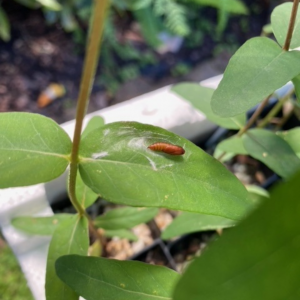
The caterpillars are pests of a wide variety of horticultural plants, fruits, deciduous trees and garden shrubs in many parts of the world. LBAM has been recorded from over 2000 different types of plants encompassing 50 plant families.
You may only find it on one or two seedlings, but it’s important to identify and remove to prevent further damage to your plants and before being transferred to the countryside where it can significantly damage crops.
If LBAM are using your seedlings as host plants, you’ll see it as eggs, larvae or caterpillar.
Signs of LBAM on your seedlings
The eggs: The moth will web leaves together or fold a single leaf to lay it’s eggs. Young eggs appear as pale blue-green, scale-like masses of 10-60 eggs on leaves or stems. Prior to hatching, the heads of caterpillars will give the mass a dark and blotchy appearance. Eggs are laid in masses on the upper surface of smooth-leaved plants. The eggs take from 5 to more than 30 days to hatch, depending on the temperature.
The caterpillar(larvae): Indications of the caterpillar’s presence are leaf rolls and leaves wrapped together. Caterpillars vary from 1mm to 1.5cm in length, depending on their stage of development. The young larvae prefer to feed on the underside of leaves and they spin a fine webbing as a protective cover. As the larvae mature, they feed between two leaves webbed together. You’ll find them in most seedlings, occurring more in those with broad leaves. The newly emerging (larvae) caterpillars are very tiny with a pale yellow-green body and a pale brown head. The adult caterpillars are pale green with a dark green central stripe.
Skeletonised leaves are also a sign of the moth on your seedling. If you see this lacing on your leaves you know that the LBAM larvae is somewhere in your seedlings. Look at everything very closely. Check every curled or oddly bent leaf.
Removing LBAM
Integrated pest consultant Jenny Chivers suggests picking affected leaves from the seedling with one hand under the leaf to catch any dropping larvae. Sqish larvae with thumb and forefinger so they cannot do further damage to seedlings. “It may seem tedious but it will be successful. The important thing is to keep regularly checking,” she advises.
Possums
Possums leave tell-tale signs of their damage to vegetation – leaves appear stripped from the plant. They are common rural and urban pests and can sometimes be found asleep in the hollows of large trees even in highly urbanised areas. When trying to prevent them, keep an eye on the telephone wires – these are the possum highway around your house.
Cause
Possums are common rural and urban pests. In urban areas keep an eye on the telephone wires, these are the possum highway around your garden.
Prevention
If you have possums in your area ensure benches are well away from overhanging ledges or branches or close platforms that the rats and possums can jump from. Seedlings need to be covered with netting or closely meshed chicken wire. The protective covering needs to be set with a gap wide enough that the possums cannot reach the seedlings with their arms and pull the head of the seedlings to eat off the tops. Eucalyptus species will be ruined if the central tip is devoured.
Cure
Possums can decimate seedlings in one night so prevention is always better than cure.
Rats and mice
Rats and mice may do more than make you jump – when the breeding population outstrips the food supply your seedlings are prime food source. Look for the pellet-shaped poo around and in the devoured seedling tubes to detect the presence of rats.
Cause
Rat and mice plagues are rural events. When the breading population out strips the food supply your seedlings are prime food source. Look for the pellet shaped poo around and ion the devoured seedling tubes to detect the presence of rats
Prevention
Ensure benches are well away from overhanging ledges, branches or close platforms that the rats and mice can jump from. The bench will need to have vertical supports that are not easily climbed – and the top needs to extend well past the vertical supports so that the critters cannot reach the edge and get on top. E.g. 44 gallon drum with large square flat top works well. Seedlings need to be covered closely meshed chicken wire.
Cure
Rats can decimate seedlings in one night so prevention is always better than cure.
Slugs and Snails
Slugs and snails will hide between tubes and boxes, so you need to look and remove them. Signs are chew marks and snail trails, and they are a common offender.
Slugs and snails will hide between tubes and boxes, so you need to look and remove them. Signs are chew marks and snail trails, and they are a common offender.
Cause
Damp, undisturbed, smooth nooks and crannies attract and house slugs and snails.
Prevention
Never put your boxes on the ground. Rotating seedling boxes for even growth provides the best opportunity to disturb and search for hidden pests.
Cure
Make sure snail bait is not placed in the tubes but around the base or bench legs to keep the snails away from young seedlings. Consider the safety of children/pets.
Webbing Caterpillar
Webbing Caterpillars are grubs that encase themselves in a web-like structure consisting of foliage and droppings and can cause severe defoliation. Leptospermum and Melaleuca are plants that are most affected by these insects.
Cause
The caterpillars build a cocoon while pulling the stems and leaves together to form a sac that looks very much like the sawdust made by a borer.
The caterpillars can totally strip the foliage, resulting in complete skeletonizing of the plant. A plant weakened in this way will not survive once planted out.
Prevention
Check daily. Watch your seedlings for webbing and insects themselves.
Cure
Manually remove the nests of material and cut off the affected branches. Removal of the sac and web by hand and elimination of the caterpillar and sac in a manner of your choice is the best form of control. However, if the infestation is severe and extensive, then chemical control with Carbaryl may be needed. A natural spray such as Dipel may be used but the results are not always as successful.
Diseases
Collar Rot
Seedlings are wilting, look weak at the base, are falling over or going rotten. Often white spider web thin white growth around the stem on soil surface is visible.
Cause
When the stems rot at the point of contact with the potting mix. This occurs when the tubes remain frequently wet on the surface overnight.
Prevention
Water early in the day so the surface mix has a chance to dry out and the seedling stems remain dry. Once collar rot is present it will most likely affect most or all of your seedlings.
Cure
No Cure. If seedlings are affected, separate them from healthy plants and destroy them – they will not survive. Ensure healthy seedlings are in a sunny, ventilated area.
Damping off
Seedlings are wilting, look weak and are falling over at the base.
Cause
Damping off is a fungal disease of seedlings. Pathogens present in the soil and water girdles the plant’s stem where it enters the soil, causing the plant to topple over. A soft decay of the taproot or rootlets causes collapse of the seedlings. Wet soil conditions stimulate pathogens. Very young or poorly growing seedlings are more prone to infection, whereas rapidly growing, vigorous plants often escape infection.
Prevention
Follow hygiene practices carefully and avoid overwatering.
Cure
By the time you identify the problem, treatment is usually too late. If there is any sign of seedlings wilting or going rotten, use a fungicide (available at your local gardening shop) and immediately spray all the seedlings. Separate unhealthy seedlings immediately. If you do not treat this promptly the fungus can quickly spread, causing the death of all your seedlings.
Frost
Frost can occur on nights with very low temperatures and can severely affect the health of a seedling. On nights when a frost is predicted cover the plants – ensuring there is no contact with the foliage – to protect seedlings from possible death.
Cause
Frost can occur on nights with very low temperatures and can severely affect the health of a seedling.
Prevention
Prevention is vital. Where a frost is predicted cover the plants ensuring there is no contact with the foliage. A frame is easy to make with a large cardboard box covered in shade cloth or material. A glass cover may be used but make sure it is removed as soon as the danger is past or the condensation and magnified sun may do just as much harm.
Cure
If your seedling is a shrub or grass and only the leaves have been affected – it may recover is the damage is not too severe. If it is a tree and the central stem has been killed the tree will be misshapen if the seedling recovers. There is no cure for a seedling where the stem been frozen.
Myrtle Rust
Myrtle Rust affects species in the Myrtaceae, which includes those belonging to Eucalyptus, Callistemon and Melaleuca. Myrtle Rust has only recently been detected in Australia along some parts of the Eastern seaboard and has the potential to severely affect our native species and our nursery industry. It is thought to have originated in Melbourne, and seems to pose an increasing problem as time goes by.
Myrtle Rust produces large amounts of powdery yellow or orange-yellow spores on the plants that have been infected. The fungus causes spots on leaves and eventually leads to curling and shrivelling of its leaves. This often kills new growth.
If you find Myrtle Rust infecting your seedlings please consider reporting it to the Department of Environment Exotic Plant Pest Hotline on 1800 084 881.
Myrtle rust has been found on the following species in Victoria:
- Lilly Pilly (Acmena smithii)
- Lemon Scented-myrtle (Backhousia citriodora)
- Bottlebrush (Callistemon viminalis) Lilly Pilly / Scrub Cherry (Sygyium austral)
- Black stallion (Lophomyrtus x ralphii)
- New Zealand Christmas bush (Metrosideros excelsa Willow myrtle (Agonis flexuosa)
- ‘Harkness’ bottlebrush (Callistemon)
Prevention
Keep an eye on foliage surrounding your growing area and remove any infected plants that are in your yard.
Cure
Destroy and bury the plants. Alternatively, you can report any sightings to the Department of Jobs, Precincts and Regions on the Exotic Plant Pest Hotline on 1800 084 881.
Phytophthora
Phytophthora is a group of fungi which cause a number of problems for plants through activity in the soil. These include collar rot and damping off. It’s difficult to diagnose phytophthora accurately without relying on laboratory tests and you can confuse it with a number of other non-disease problems, such as drought stress. Phytophthora may also cause leaves to develop brown patches at the tips and margins and the yellowing off and dying back of foliage.
It’s difficult to diagnose the disease accurately without relying on laboratory tests and you can confuse it with a number of other non-disease problems, such as drought stress. Leaves may develop brown patches at the tips and margins and there is generally a yellowing off and dying back of foliage.
The foliage dries out and young feeder roots darken.
Cause
Phytophthora attacks the roots and stems of plants, destroying the root system and reducing the ability of the plant to absorb water and nutrients. The young roots become dark and rot. Plants wilt, yellow and may appear dry and infection may result in the death of the plant. Symptoms are often more severe, when plants are suffering from water stress.
Prevention
Prevention is far easier than cure because by the time you notice the rot it is often too late to treat. Hygiene is the crucial factor.
Always sterilize equipment and clean after use. Make sure there is adequate airflow and wet potting mix is not left lying about.
This is not as common today due to strict growing conditions throughout the nursery industry.
Cure
No cure. Destroy any infected stock and prevent contamination by using good hygiene practices.
Powdery Mildew
Powdery mildew is a common problem, particularly for eucalypts. It will appear as a whitish or purple powdery substance on the leaves and stems or brown spots on the leaves. Advanced attacks of powdery mildew will damage young emerging leaves and eventually kill the plant.
Cause
It is generally a cooler-month problem, caused by too much moisture remaining on the plant, particularly overnight. The temperature is not warm enough for the moisture to evaporate. It also occurs if the seedlings are in too much shade or if they have not been thinned, preventing air circulation around the individual seedlings.
Prevention
Early stages of mildew will usually only set back a plant, rather than kill it; however you will need to act quickly, remove and discard any badly affected seedlings. Keep foliage dry in cool weather, particularly at night; ensure the seedlings are in full sun and make sure that you thin out the seedlings early enough.
Cure
You can buy mildew products at your local garden shop. Follow directions carefully. You can also use a milk solution, mixing 1 part whole milk to 5 parts water which you directly spray onto the affected areas every second day.
Pesky Weeds
Cyperus
If you perhaps come across Cyperus (nutgrass) please ensure that this very invasive weed Cyperus (nutgrass) is taken out of tubes before the seedlings are delivered. It’s a really bad weed for farms. Pictures of this weed are shown here at 2,4 and 6 months. For more information on this weed, this link has a close-up of the leaf and talks about the devastating effect on farmland:

